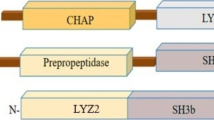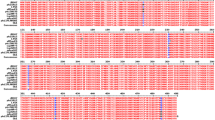Abstract
Staphylococcus aureus causes a wide range of suppurative infections in humans and animals. Due to its high virulence, ability to adopt various environmental conditions, and acquired multiple drug resistance, treatment of such infections has become difficult. Therefore, there is an immense need to develop alternate drug modalities to control this pathogen. In past few years, phage-encoded endolysin therapy has emerged as a new hope not only due to its ability to specifically kill the target bacteria irrespective of their antibiotic sensitivity but also because of minimum or no side effects, a problem associated with antibiotic therapy. In this article, we report purification of a broad spectrum anti-staphylococcal endolysin (P-27/HP endolysin) encoded by phage P-27/HP isolated from sewage water. On SDS-PAGE endolysin resolved in three polypeptides of molecular weights 33.5, 48.6, and 62.2 kDa. Endolysin exhibited maximum in vitro lytic activity at temperature between 35 and 40°C and pH 7.0. In vivo experiments revealed considerable (99.9%) elimination of S. aureus 27/HP from spleens of endolysin-treated mice and had saved them from death due to bacteremia caused by S. aureus 27/HP challenge infection. Thus, P-27/HP endolysin offers suitable substitute of antibiotics to control S. aureus infections.




Similar content being viewed by others
References
Borysowski J, Weber-Dabrowska B, Gorski A (2006) Bacteriophage endolysins as a novel class of antibacterial agents. Exp Biol Med (Maywood) 231(4):366–377
Capparelli R, Parlato M, Borriello G et al (2007) Experimental phage therapy against Staphylococcus aureus in mice. Antimicrob Agents Chemother 51(8):2765–2773. doi:10.1128/AAC.01513-06
Casey AL, Lambert PA, Elliott TSJ (2007) Staphylococci. Int J Antimicrob Agents 29(3):S23–S32. doi:10.1016/S0924-8579(07)72175-1
Chambers HF (2005) Community-associated MRSA—resistance and virulence converge. New Engl J Med 352(14):1485–1487
Fischetti VA (2010) Bacteriophage endolysins: a novel anti-infective to control Gram-positive pathogens. Int J Med Microbiol 300(6):357–362. doi:10.1016/j.ijmm.2010.04.002
Górski A, Miedzybrodzki R, Borysowski J, Weber-Dabrowska B, Lobocka M, Fortuna W, Letkiewicz S, Zimecki M, Filby G (2009) Bacteriophage therapy for the treatment of infections. Curr Opin Investig Drugs 10(8):766–774
Gupta R, Prasad Y (2011) Efficacy of polyvalent bacteriophage P-27/HP to control multidrug resistant Staphylococcus aureus associated with human infections. Curr Microbiol 62(1):255–260. doi:10.1007/s00284-010-9699-x
Hermoso JA, García JL, García P (2007) Taking aim on bacterial pathogens: from phage therapy to enzybiotics. Curr Opin Microbiol 10(5):461–472. doi:10.1016/j.mib.2007.08.002
Jado I, Lopez R, Garcia E, Fenoll A, Casal J, Garcia P (2003) Phage lytic enzymes as therapy for antibiotic-resistant Streptococcus pneumoniae infection in a murine sepsis model. J Antimicrob Chemother 52(6):967–973. doi:10.1093/jac/dkg485
Kutter E, De Vos D, Gvasalia G, Alavidze Z, Gogokhia L, Kuhl S, Abedon ST (2010) Phage therapy in clinical practice: treatment of human infections. Curr Pharm Biotechnol 11(1):69–86
Loessner MJ (2005) Bacteriophage endolysins—current state of research and applications. Curr Opin Microbiol 8(4):480–487. doi:10.1016/j.mib.2005.06.002
Lowy FD (1998) Staphylococcus aureus infections. N Engl J Med 339(8):520–532
Lowy FD (2003) Antimicrobial resistance: the example of Staphylococcus aureus. J Clin Invest 111(9):1265–1273. doi:10.1172/JCI200318535
Manoharadas S, Witte A, Blasi U (2009) Antimicrobial activity of a chimeric enzybiotic towards Staphylococcus aureus. J Biotechnol 139(1):118–123. doi:10.1016/j.jbiotec.2008.09.003
Matsuzaki S, Yasuda M, Nishikawa H, Kuroda M, Ujihara T, Shuin T, Shen Y, Jin Z, Fujimoto S, Nasimuzzaman MD, Wakiguchi H, Sugihara S, Sugiura T, Koda S, Muraoka A, Imai S (2003) Experimental protection of mice against lethal Staphylococcus aureus infection by novel bacteriophage phi MR11. J Infect Dis 187(4):613–624. doi:10.1086/374001
Nelson D, Loomis L, Fischetti VA (2001) Prevention and elimination of upper respiratory colonization of mice by group A streptococci by using a bacteriophage lytic enzyme. Proc Natl Acad Sci USA 98(7):4107–4112. doi:10.1073/pnas.061038398
O’Flaherty S, Ross RP, Coffey A (2009) Bacteriophage and their lysins for elimination of infectious bacteria. FEMS Microbiol Rev 33(4):801–819. doi:10.1111/j.1574-6976.2009.00176.x
Obeso JM, Martinez B, Rodriguez A, Garcia P (2008) Lytic activity of the recombinant staphylococcal bacteriophage ΦH5 endolysin active against Staphylococcus aureus in milk. Int J Food Microbiol 128:212–218. doi:10.1016/j.ijfoodmicro.2008.08.010
Parisien A, Allain B, Zhang J, Mandeville R, Lan CQ (2008) Novel alternatives to antibiotics: bacteriophages, bacterial cell wall hydrolases, and antimicrobial peptides. J Appl Microbiol 104(1):1–13. doi:10.1111/j.1365-2672.2007.03498.x
Payne D, Tomasz A (2004) The challenge of antibiotic resistant bacterial pathogens: the medical need, the market and prospects for new antimicrobial agents. Curr Opin Microbiol 7(5):435–438. doi:10.1016/j.mib.2004.08.017
Service RF (2004) Orphan drugs of the future? Science 303(5665):1798. doi:10.1126/science.303.5665.1798
Sonstein SA, Hammel JM, Bondi A (1971) Staphylococcal bacteriophage-associated lysin: a lytic agent active against Staphylococcus aureus. J Bacteriol 107(2):499–504
Takác M, Bläsi U (2005) Phage P68 virion-associated protein 17 displays activity against clinical isolates of Staphylococcus aureus. Antimicrob Agents Chemother 49(7):2934–2940. doi:10.1128/AAC.49.7.2934-2940.2005
Witzenrath M, Schmeck B, Doehn JM, Tschernig T, Zahlten J, Loeffler JM, Zemlin M, Müller H, Gutbier B, Schütte H, Hippenstiel S, Fischetti VA, Suttorp N, Rosseau S (2009) Systemic use of the endolysin Cpl-1 rescues mice with fatal Pneumococcal pneumonia. Crit Care Med 37(2):642–649
Conflict of interest
Authors declare that they have no conflict of interest.
Author information
Authors and Affiliations
Corresponding author
Rights and permissions
About this article
Cite this article
Gupta, R., Prasad, Y. P-27/HP Endolysin as Antibacterial Agent for Antibiotic Resistant Staphylococcus aureus of Human Infections. Curr Microbiol 63, 39–45 (2011). https://doi.org/10.1007/s00284-011-9939-8
Received:
Accepted:
Published:
Issue Date:
DOI: https://doi.org/10.1007/s00284-011-9939-8




